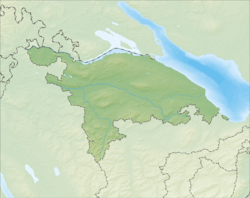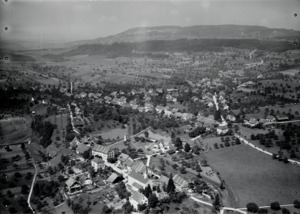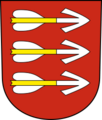Pfyn facts for kids
Quick facts for kids
Pfyn
|
||
|---|---|---|
 |
||
|
||
| Country | Switzerland | |
| Canton | Thurgau | |
| District | Steckborn | |
| Area | ||
| • Total | 13.14 km2 (5.07 sq mi) | |
| Elevation | 411 m (1,348 ft) | |
| Population
(Dec 2020 )
|
||
| • Total | 2,103 | |
| • Density | 160.05/km2 (414.52/sq mi) | |
| Postal code |
8505
|
|
| Surrounded by | Felben-Wellhausen, Herdern, Homburg, Hüttlingen, Müllheim, Warth-Weiningen | |
Pfyn is a town in Switzerland. It is located in the Thurgau area.
Pfyn is famous for the ancient Pfyn culture. This was a group of people from the Stone Age (around 3900 BC to 3500 BC). They were known for raising many pigs and trading goods.
The town was also a Roman outpost called Ad Fines. This Latin name means "at the borders," because it was on the edge of Roman provinces.
Contents
History of Pfyn
Ancient Settlements in Pfyn
The very first signs of people living here were found about 1.5 kilometers (about 1 mile) west of Pfyn. This area, called Breitenloo, was once a peat bog. It dates back to the Stone Age, around 4300 BC.
The settlement was found in the late 1800s but was later forgotten. During World War II, efforts to drain the bog led to its rediscovery. Polish soldiers helped dig up about 1,000 square meters (about 10,760 square feet) of the site in 1944.
Experts first thought the pottery found here was from a different culture. But by 1960, they realized it was unique. This led to the discovery of the Pfyn culture, named after this site.
Later studies in 2002 and 2004 helped date the settlement precisely. Wood found at the site shows that trees were cut in 3706-3704 BC. This means the settlement was built and used around that time.
Another Stone Age settlement might have been nearby, but it was likely destroyed. Besides the Pfyn culture, archaeologists have also found items from the Bronze Age and Iron Age in the area.
Roman Times in Pfyn
Pfyn was definitely the Roman outpost known as Ad Fines. This name referred to the border between Roman provinces. Roman roads passed through Pfyn, connecting important towns.
Not much is left of the early Roman settlement. However, a late-Roman fort was built outside the town. This fort is now partly gone due to rivers eroding the land.
Inside the fort, many Roman coins and objects were found. These show that Roman soldiers, including horse riders, lived there. They stayed from the late 200s AD until the early 400s AD. The fort helped protect the Roman border along the Rhine River.
We don't know exactly when the fort was left empty. But a nearby church, St. Bartholomew's, suggests people continued to live in the area.
Pfyn in the Middle Ages
Many medieval graves have been found inside St. Bartholomew's Church. During the Middle Ages, the Bishop of Constance was the main landlord of Pfyn.
In 1414 and 1502, the village gained some rights to govern itself. The village was owned by different noble families over the centuries. In 1614, the city of Zürich bought Pfyn. Zürich then appointed a local ruler, called a Vogt, who governed until 1798.
In 1476, a big fire destroyed the old town of Pfyn. It had been built on the ruins of the Roman fort. The new village was then built a bit to the northwest. In the late 1700s, Pfyn built a bridge over the Thur River. They collected tolls (fees) from people using the bridge until 1850.
St. Bartholomew's Church was very important in the Middle Ages. It was the main church for many nearby villages. Over time, some of these villages got their own churches and became independent.
In 1155, the Cathedral Chapter of Constance gained control over the church in Pfyn. This meant they could choose the priest. In 1528, the Protestant Reformation reached Pfyn, and the village became Protestant for a short time. However, many nearby villages stayed Catholic. By 1533, a Catholic priest was back in Pfyn. Today, the church is still shared by both Protestants and Catholics.
Geography of Pfyn
Pfyn covers an area of about 13.18 square kilometers (about 5 square miles). Most of this land, about 59.5%, is used for farming. Forests cover about 30.2% of the area.
About 8% of the land has buildings or roads. A small part, 1.4%, is rivers or lakes. The rest is unproductive land.
The town is located on the Thur River. It sits between the towns of Frauenfeld and Steckborn. Pfyn includes the main village and smaller areas called hamlets. These hamlets are Herdern, Lanzenneunforn, Weiningen, and Dettighofen.
People of Pfyn (Demographics)
Pfyn has a population of about 2,000 people. About 10.9% of the people living in Pfyn are from other countries. Over the past ten years, the population has grown by about 11.7%.
Most people in Pfyn (93.0%) speak German. Albanian is the second most common language, and Italian is third.
In 2008, there were slightly more men (50.3%) than women (49.7%) in Pfyn. The population is made up of Swiss citizens and people from other countries.
The age groups in Pfyn are:
- Children (0-9 years old): 11.1%
- Teenagers (10-19 years old): 12.7%
- Young adults (20-29 years old): 11.9%
- Adults (30-59 years old): 46%
- Seniors (60+ years old): 18.3%
In 2000, there were 687 households in Pfyn. On average, each household had 2.6 people. Most homes (82.9%) were single-family houses.
Here is how Pfyn's population has changed over time:
| year | population |
|---|---|
| 1850 | 789 |
| 1860 | 810 |
| 1870 | 868 |
| 1880 | 877 |
| 1890 | 857 |
| 1900 | 891 |
| 1950 | 1,187 |
| 1960 | 1,247 |
| 1980 | 1,198 |
| 1990 | 1,578 |
| 2000 | 1,804 |
Important Historical Sites
Three sites in Pfyn are very important to Swiss history:
- The Ad Fines (a late-Roman fort)
- The Breitenloo (a prehistoric lake shore settlement)
- The shared church of St. Bartholomäus (used by both Catholics and Protestants)
The Ad Fines fort was studied in the 1970s, 80s, and 90s. Its walls were about 3 meters (10 feet) high. Six semi-circular towers have been found. The fort covered an area of about 15,000 square meters (161,460 square feet). Inside, a fountain and parts of wooden buildings were found. Many coins and objects show that Roman soldiers lived there from the late 200s to the early 400s AD.
At the Breitenloo prehistoric site, 17 ancient houses were found in 1944. These houses were built close together along a main street. They were usually long and narrow, between 4 and 11 meters (13-36 feet) long. Some houses were much larger than others, suggesting they might have been homes with smaller farm buildings next to them.
Economy of Pfyn
In 2007, the unemployment rate in Pfyn was very low, at 0.93%.
Many people in Pfyn work in different types of jobs:
- Primary sector: This includes farming and forestry. About 134 people work in this area, with around 50 businesses.
- Secondary sector: This includes manufacturing and construction. About 343 people work here, with 27 businesses.
- Tertiary sector: This includes services like shops, schools, and healthcare. About 216 people work in this sector, with 53 businesses.
In 2000, about half of the people who lived in Pfyn worked outside the town. However, many people also traveled into Pfyn for work. Most people (54.7%) used a private car to get to work, while 8.9% used public transportation.
Religion in Pfyn
Based on the 2000 census:
- 28.9% of the people were Roman Catholic.
- 47.3% belonged to the Swiss Reformed Church (Protestant).
- About 6.54% belonged to other Christian churches.
- About 4.82% were Islamic.
- About 7.98% said they had no religion or were agnostic or atheist.
Education in Pfyn
Many adults in Pfyn have completed higher education. About 78.1% of people aged 25-64 have finished high school or gone on to university.
Pfyn has its own primary school district. In the 2008/2009 school year, there were 146 students.
- There were 36 children in kindergarten.
- There were 55 children in the lower primary grades.
- There were 55 children in the upper primary grades.
The average class size in primary school was 20 students.
Images for kids
See also
 In Spanish: Pfyn para niños
In Spanish: Pfyn para niños







